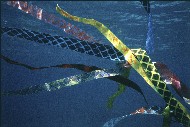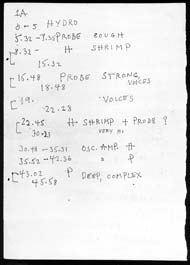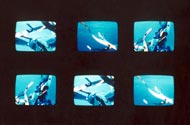 |

 |
 |
Colored postcard for Sea Tails, 1983
|
 |
Sea Tails (1983) is a six-screen, three-channel video installation that combines electronic music by David Tudor with footage taken by Molly Davies of Jackie Matisse's kites moving through the ocean. This exhibition draws on the special collections of the Research Library at the Getty Research Institute to recreate the original installation of Sea Tails and reveal the working process of its creators.
|
 |

 |
 |
Jackie Matisse, David Tudor, and Molly Davies at the Whitney Museum, New York, 1986
|
 |
 |
Sea Tails is the work of three artists: kite artist Jackie Matisse, composer David Tudor, and filmmaker Molly Davies.
Jackie Matisse creates kites and kite-like sculptures from cloth, paper, and metal. Her works use motion, line, and color to sculpt air and water. Matisse collaborated with Tudor on several installations in the 1980s and 1990s.
David Tudor (1926–1996) was a virtuoso pianist and a pioneering composer and performer of electronic music. He collaborated extensively with such avant-garde artists as John Cage, Karlheinz Stockhausen, and Merce Cunningham.
Molly Davies has been making experimental films and multimedia installations since the late 1960s. Music has always been an important part of Davies's work, and she has worked with numerous musicians including Tudor's lifelong collaborator John Cage.
|
 |
 |

 |
 |
David Tudor on the Boat in Nassau, Bahamas, 1983
|
 |
The artists spent eight days on a boat off Nassau, Bahamas, in February 1983. Matisse had made painted kites in four different colors, sizes, and materials. She pulled the kites through the ocean with the assistance of divers, while Davies filmed.
Tudor stayed on the boat to record the score. He lowered microphones into the water to various depths and recorded the unusual sounds of grouper, grunt fish, and shrimp eating off coral. Voices, splashes, and the boat's flags flapping in the wind were also captured on the tapes.
|
 |

 |
 |
List of Contents of Source Recordings, David Tudor, 1983
|
 |
 |
Tudor later categorized the recordings and made notes of their contents. He then layered, mixed, and rerecorded the sounds onto three separate tapes.
On the page shown here, Tudor classified the sounds on one 46-minute tape as hydro (water), probe, shrimp, voices, and coughing.
|
 |
 |

 |
 |
Plan for Ten-Minute Demonstration of Videotape, Molly Davies, 1983
|
 |
For each of the three videos, Davies and Matisse edited the kite footage into three 7½-minute segments. They sent the footage to Tudor along with a chart of its content and a sketch of the four kite types, shown here.
Tudor transcribed and annotated Davies and Matisse's notes and selected 12 sounds from his recordings to go with the images. He then devised a system of notation to help him match the sounds to the footage. Tudor named the three videos A, B, and C and gave each sound a number between 1 and 12. He also identified the tape that was the source of each sound. The mixing of the final tapes took place at a recording studio in Paris, where the three collaborators worked together.
|
 |

 |
 |
Schematic for Sea Tails, David Tudor, 1983
|
 |
 |
|
|
 |
In planning his compositions and performances, Tudor typically created a schematic, a diagram using a standardized vocabulary of symbols. His Sea Tails schematic details the setup of his live performance of the piece. The setup includes tape decks, filters, mixers, and a surround-sound panner, a device to control the effects produced by the six speakers in the performance space.
|
 |
|
Sea Tails received its premiere as a video installation at the Pompidou Center in Paris on June 3, 1983. Tudor later performed Sea Tails live in Frankfurt, Stockholm, and New York City by manipulating the sounds at a mixing table. He described the result as a "new enhanced version of the sound tracks." Sea Tails was a unique sound piece in Tudor's body of work because it could be presented both as a video installation and as an installation with live performance.
Just as Tudor introduced flexibility into the score of Sea Tails, Davies and Matisse varied the format of the video installation. In the versions of Sea Tails shown in Philadelphia and New York City, for example, they stacked three monitors vertically and enclosed them in a black casing.
|
 |






